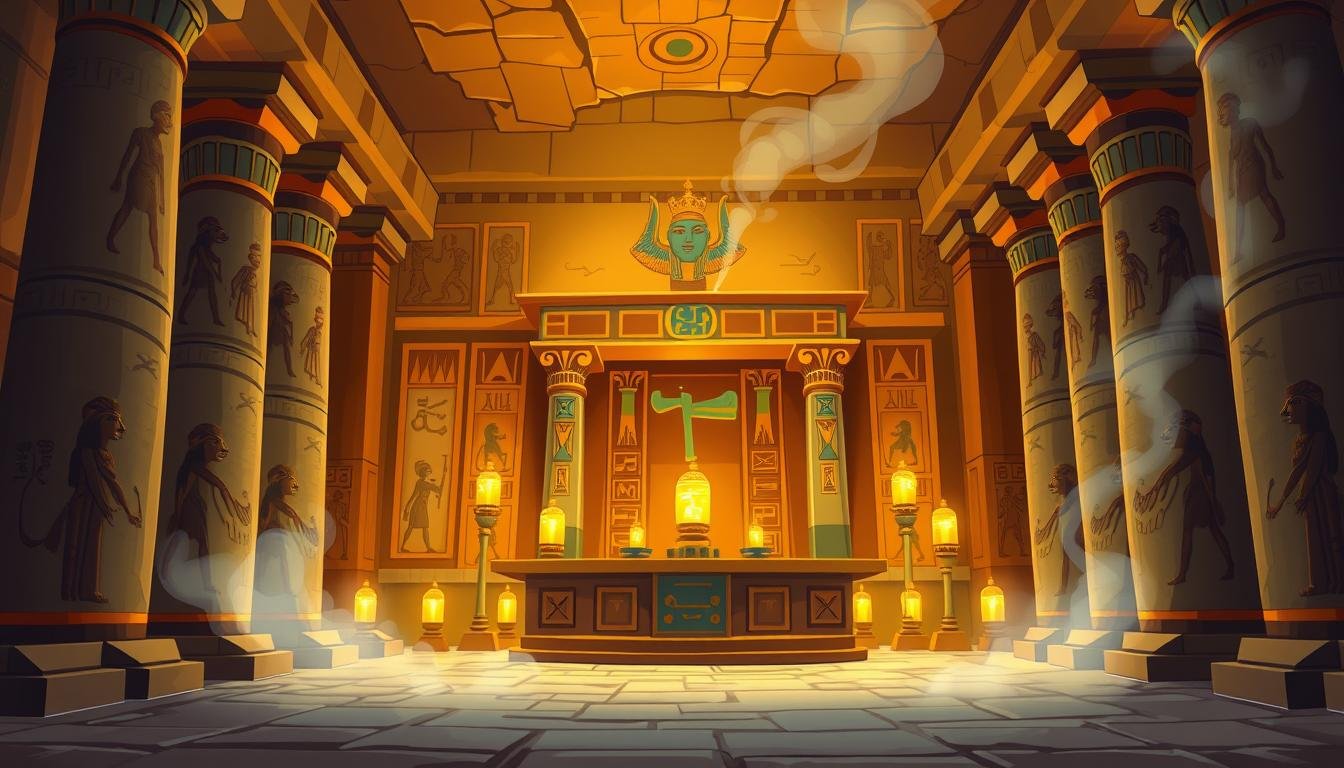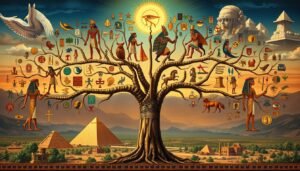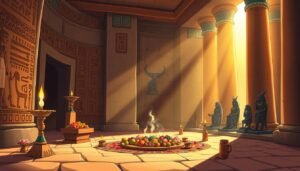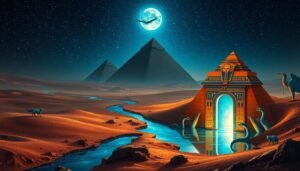In ancient Egypt, the Nile River was like life itself. A god named Amun, the Hidden One, was born from these waters. His name was spoken with awe, hinting at the mysteries of the universe1.
As time went on, Amun became more powerful. He merged with the sun god Ra to become Amun-Ra. This powerful being was known as “the Great I Am” and was all about life, abundance, and creation1.
The Amun Ra ritual was a special way to honor the sun god. It mixed the secrets of Amun with Ra’s bright power. This ancient wisdom showed us the spiritual world of the Egyptians, full of mystery and beauty.
The rituals of Amun were recorded on old papyri, like the “Hymns to Amun” on Papyrus Leiden I 350 from 1213 BCE2. These writings showed the lasting impact of this great god.
At its peak, Amun’s worship was huge. During Ramesses III’s rule, 81,322 people served the god. This included priests, peasants, and many others2.
Amun was incredibly wealthy. He owned 433 gardens, 591,320 acres of fields, 83 boats, and 46 construction sites. He even had 65 towns2. This showed how much people loved and respected Amun.
The Amun Ra ritual was filled with tradition. It included offerings like bread, beer, and fresh flowers3. The air was filled with the sweet smell of frankincense, making everything feel sacred3.
Key Takeaways
- Amun, the Hidden One, and Ra, the sun god, merged to form the supreme deity Amun-Ra in ancient Egyptian religion.
- The sacred Amun Ra ritual combined the mysterious aspects of Amun with the visible power of Ra, offering insights into ancient Egyptian spirituality.
- During the reign of Ramesses III, Amun had a vast following, with over 81,000 individuals in his service and immense wealth.
- Traditional offerings in the Amun Ra ritual included bread, beer, onions, dates, figs, pomegranates, roast fowl, beef, and an abundance of fresh flowers.
- Pure frankincense resin incense, the sole type used in ancient temples, created a sacred atmosphere during the ritual.
The Enigmatic Amun: Hidden God of Ancient Egypt
In ancient Egypt, Amun was a mysterious god. He started as a local god in Thebes. But, he became very important in the universe4.
Amun was known as “Him whose name is hidden.” This made him different from other gods. They were linked to things we can see and touch.
Amun became famous during the New Kingdom (c. 1570-1069 BCE). His cult was the most popular for a long time4. He went from a local god to a national one5.
The Second Intermediate Period saw the Hyksos rise. But, Amun’s mystery helped him grow. He took on qualities from other gods4.
As Amun’s power grew, so did his art. He was shown as a bearded man or a ram. This showed he was both seen and unseen4.
“Amun, whose name is hidden, whose form is unknown, whose size cannot be ascertained, whose beginning cannot be found, and whose end cannot be reached.”
Amun’s mystery spread beyond Egypt. It was through military and cultural exchanges5. He became Amun-Ra, the creator and King of the Gods4.
Amun’s rise and mystery made him a lasting figure in Egyptian religion. He was the god of the unseen. His mystery captivated the ancient Egyptians for centuries4.
Rise of Amun-Re: Theban Triad and New Kingdom Prominence
The rise of Amun-Re as the top god shows how ancient Egyptian beliefs changed. The city of Thebes grew strong, and so did its god, Amun. Amun became a big deal in the Theban triad, with his wife Mut and son Khonsu.
Amun’s Ascent to Supreme God Status
The New Kingdom era, from 1539-1075 BCE6, saw Amun’s power grow. He was seen as a god who helped win battles. His temple at Karnak became a huge place of worship.
“Amun, the hidden one, whose true form remains unknown, yet whose presence permeates the very fabric of existence.”
Amun became the main god over a thousand years. He almost became the only god in the New Kingdom period7. The temple of Amun-Ra at Karnak was very rich during this time7.
Fusion with Ra: Embodying the Seen and Unseen
Amun became even more important when he merged with Ra, the sun god. This made Amun-Re, a god of both the hidden and the seen. He became the top solar deity, mixing mystery with power.
- Amun, the hidden creator god
- Ra, the visible sun god
- Amun-Re, the supreme god embodying the seen and unseen
The Theban triad, led by Amun-Re, had a lot of power in the New Kingdom. The Feast of Opet was a big event where Amun’s boat was moved from Karnak to Luxor7. Priests thought all gods in Egypt were parts of Amun-Re7.
| God | Role | Worship Center |
|---|---|---|
| Amun | Hidden creator god | Karnak |
| Ra | Sun god | Heliopolis |
| Amun-Re | Supreme god of the seen and unseen | Thebes |
So, Amun-Re became the most important god in the New Kingdom. He changed ancient Egyptian religion forever867.
Amun-Re: King of the Gods and Ruler of the Cosmos
Amun-Re was the cosmic ruler of ancient Egypt. He was seen as the most powerful god. He brought order to the world.
The One and the Millions: Amun-Re’s Paradoxical Nature
Amun-Re was both one and many. He was the source of creation and all divine powers. This idea helped Egyptians see him as the top cosmic ruler.
The eleventh dynasty from Thebes helped make Amun more important. They named their rulers after him9. This made him the king of gods.
In the realm of the divine, Amun-Re reigned supreme,
His essence permeating the cosmos, from earth to the unseen.
The One and the Millions, a paradox to behold,
Amun-Re, the source of all, the mysteries untold.
Amun-Re as the Source of Divine Emanations
As the king of gods, Amun-Re was seen as the source of all gods. Deities like Hathor and Horus were parts of him10. This made him very important in the Egyptian pantheon.
| Deity | Role | Relation to Amun-Re |
|---|---|---|
| Hathor | Goddess of sexuality, fertility, and motherhood | Emanation of Amun-Re’s creative power |
| Horus | God of kingship and the reigning pharaohs | Embodiment of Amun-Re’s authority |
| Osiris | God of fertility and the Nile inundations | Expression of Amun-Re’s life-giving essence |
| Isis | Goddess associated with the power of the throne | Manifestation of Amun-Re’s divine power |
Amun-Re was the source of all gods. He brought order and unity to the world. His cult became very important in Egypt9. He was seen as the supreme cosmic ruler.
The Amun Ra Ritual: Sacred Rites of the Hidden One
In ancient Egypt, the Amun Ra ritual was very important. It honored the Hidden One and his connection to the sun god Ra. This ritual was key during the New Kingdom period, from 1550 BCE to 1070 BCE11.
The temples where these rituals took place were huge and beautiful. The Karnak complex in Thebes was one of them. It was where Amon’s cult grew strong since 2008–1957 BCE12.
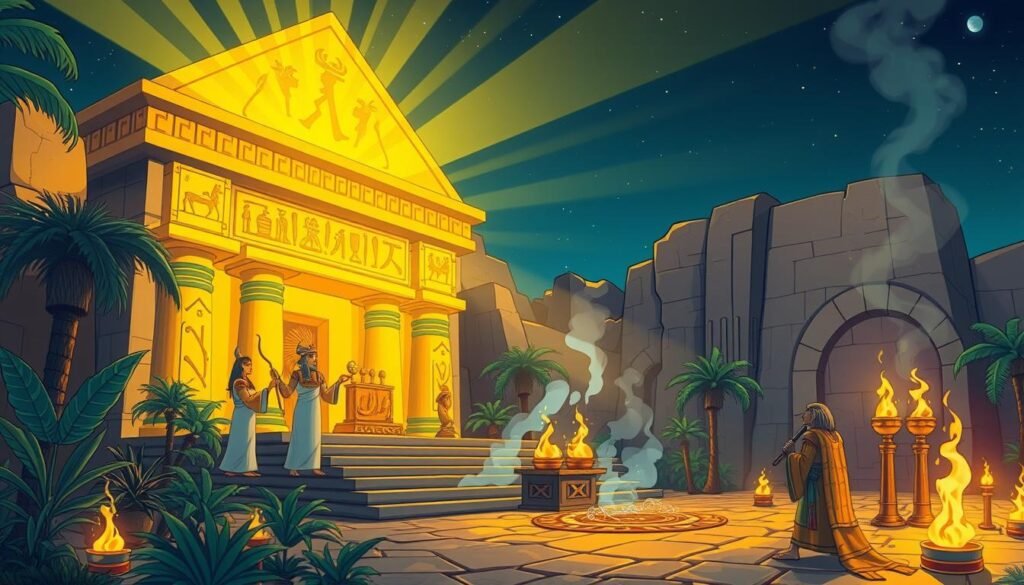
Before starting the rituals, priests purified themselves. They cleaned their bodies and souls to meet the divine. In these places, the statue of Amun-Ra waited for offerings and prayers.
The priests gave the god many things. They offered food, drink, incense, and prayers. These acts kept the god’s favor on Egypt.
The Amun Ra ritual showed Egypt’s wealth and beauty. The Karnak temple was huge and rich from the New Kingdom on12. Pharaohs like Hatshepsut and Ramesses II made the temples even more beautiful11.
The ritual was more than just a ceremony. It brought the god’s blessings to the land. The Nile flood, seen as Amun-Ra’s gift, was vital for farming11.
The Amun Ra ritual was a symbol of ancient wisdom. It showed the power of the Hidden One. From Karnak to small shrines, the rituals honored Amun-Ra for centuries.
Temples of Amun-Re: Earthly Abodes of the Divine
In ancient Egypt, gods were very powerful and almost immortal13. The temples for Amun-Re showed his great power. These places were filled with beautiful art and big statues. People went there to feel the god’s presence and to ask for his help.
Karnak: Amun-Re’s Grand Sanctuary
The Karnak temple complex was huge and very important. It was in Thebes, at the heart of Egypt. It was Amun-Re’s main place of worship, filled with stories of the god14.
Pharaohs led rituals and made offerings to keep Amun-Re happy15. The temple showed the god’s power and his big role in Egyptian life.
Luxor Temple: Amun-Re’s Southern Ipet
The Luxor Temple was another important place for Amun-Re. It was by the Nile River, south of Karnak. It was connected to Karnak by a special road with sphinxes.
Every year, the Opet Festival was held. Amun-Re’s statue was carried from Karnak to Luxor. This showed the god’s power and his importance13.
The Luxor Temple’s walls had beautiful art and writings. They showed the rituals and ceremonies that happened there. Pharaohs came to keep things balanced between the world and the gods15.
The temples of Amun-Re helped connect the human world with the divine. They made sure Amun-Re’s power was always remembered in Egypt.
Amun Beyond Egypt: Expansion, Syncretism, and Influence
Amun’s name echoed through ancient Egypt. His influence spread far beyond the Nile. He became a key figure in distant lands, blending with other myths and gods.
In Nubia, Amun found a new home. His worship grew under the sun. The Nubians merged him with their solar god, showing great respect16.
The Kushites also honored Amun, making him their top god. This helped them feel they had the right to rule16.
The Greeks were amazed by Amun. They saw him as a version of their own Zeus. This created Zeus-Ammon, showing how gods can blend together16.
“In the heart of the Siwa Oasis, an oracle spoke the words of Amun, drawing pilgrims from far and wide. Even the great conqueror, Alexander, sought the god’s blessing, kneeling before the oracle to receive confirmation of his own divinity and right to rule.”
Amun’s name was revered worldwide. People sought his guidance and favor. The Siwa Oasis oracle was famous for its wisdom, even in the classical period16.
Great leaders like Alexander traveled to meet the oracle. They wanted Amun’s blessing and to know they were chosen16.
Amun’s influence went across cultures and borders16. His worship in Egypt spread to Nubia and more. He became a link between different worlds, showing how gods can connect us17.
Through time, Amun’s legacy lived on. His journey shows the power of faith and the human spirit. It also shows the lasting appeal of divine mysteries.
Priests of Amun: Servants of the Hidden God
In ancient Egypt, gods and people lived together. The priests of Amun were special servants of the hidden god. They were both men and women who lived to help Amun-Re, the top god.
Their job was different from today’s preachers. They took care of the gods in the temple18. Priests and priestesses worked in groups, serving the temple for a month every four18.
Purification Rituals: Preparing to Serve Amun
Before they could enter Amun’s temple, priests went through special cleaning rituals. They bathed in sacred lakes to clean their bodies and souls. They wore clean linen clothes, showing they were ready to meet the gods.
Daily Rituals: Tending to Amun-Re’s Needs
Every day, priests did special rituals for Amun-Re. They opened the shrine and gave him food, drink, and incense. They also cleaned his statue to keep him pure.
The priests had different jobs and levels19. The high priest had big responsibilities18. Most priests were called ‘wab’, which means ‘pure one’19.
They sang hymns and chants in the temple. The smell of incense filled the air. This was how they kept the world in balance and made Amun-Re happy.
The priests of Amun were like the hidden god’s helpers. They kept the connection between gods and people strong. Their rituals made sure Amun-Re was always happy and present in their hearts.
Festivals of Amun-Re: Opet and the Valley Feast
In ancient Egypt, the festivals of Amun-Re were grand. They showed the god’s power and his bond with the pharaoh and people. The Opet Festival was a highlight, honoring the Theban Triad—Amun, Mut, and Khonsu. It was a time when statues of these gods moved from Karnak to Luxor Temple, symbolizing renewal and fertility20.
The Opet Festival lasted 11 to 20 days, making it the longest festival in Thebes20. The Beautiful Opet Feast, another big event, lasted twenty-four days21.
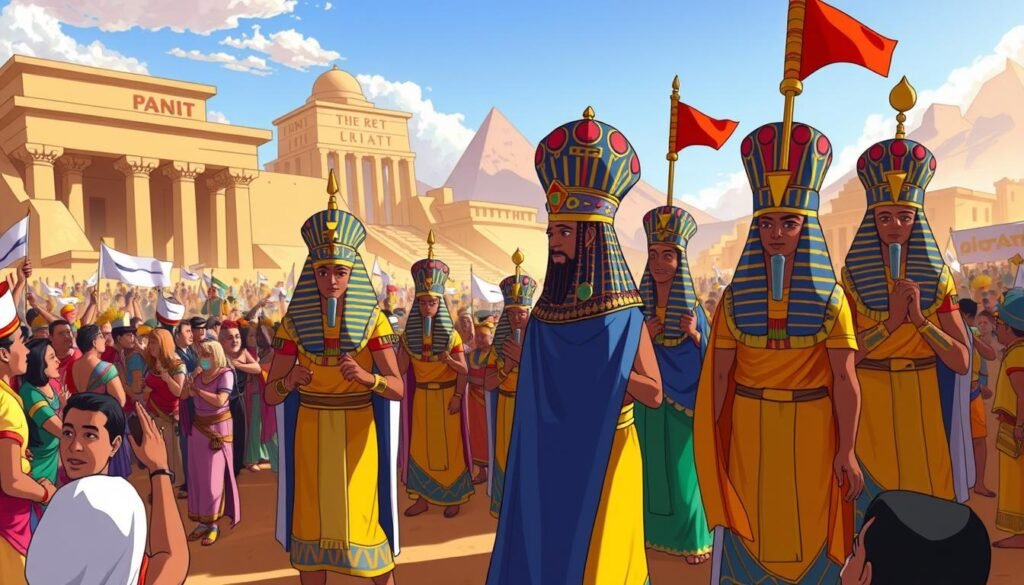
The Valley Festival was another important event. It brought Amun-Re to the Theban Necropolis. This festival was very popular, especially in the New Kingdom21.
The Feast of the Valley started on the first day of summer’s second month, with the New Moon21. It happened between harvest and the Nile’s flood, times of plenty and new beginnings20.
In the heart of the Feast of the Valley lies the awe-inspiring parade of cult statues, portraying Gods and deceased royalty in a breathtaking display of divine might and ancestral reverence21.
The Valley Festival’s processions were very special. They showed the connection between life and death. Statues of Amun-Re and royal ancestors were carried, showing the link between the living and the dead. People watched from the West bank of Thebes, seeing the transition from life to death21.
| Festival | Timing | Duration | Significance |
|---|---|---|---|
| Opet Festival | Annual | 11-20 days | Renewal of divine kingship and fertility |
| Valley Festival | Annual, 1st day of 2nd month of summer | 2 days | Honoring deceased royalty, linking living and dead |
| Wag Festival | During harvest season (Feb/Mar) | 1-2 days | Honoring deceased ancestors |
The Temple of Amon-Ra was key in the Valley Festival21. It was a place of deep spiritual importance. The temple’s halls saw sacred rites and ceremonies, honoring the divine and the ancestors. This ensured Egypt’s well-being and the cosmic cycle’s continuation.
These grand festivals made Amun-Re’s presence felt in ancient Egyptian society. They connected the divine, royal, and common people in a tapestry of devotion, renewal, and eternal remembrance.
Oracles of Amun: Divine Guidance for Pharaohs and Commoners
In ancient Egypt, about 2000 gods and goddesses were worshipped22. The amun oracles were like beacons of wisdom. They guided pharaohs and commoners. Amun, the god of wind and secrets, became Amun-Re with Ra, the sun-god22.
Through the egyptian prophecy of the Amun oracles, the will of Amun-Re was revealed.
The ancient Egyptians looked to Amun-Re for guidance in hard times. They believed the oracle’s words were true. In a world where writing was magical23, the Amun oracles’ words were powerful.
“O Amun-Re, great god, lord of what is, king of eternity, sole one, who made what exists.”
– Hymn to Amun-Re
The Amun oracles’ influence went beyond the spiritual. They shaped politics and laws in ancient Egypt. Pharaohs used them to justify their rule. Common people sought guidance for personal matters.
The Greeks also believed in the power of gods for divination from the 5th Century B.C23..
In ancient Egypt, people believed in luck and unlucky days, especially in the New Kingdom period23. They tried to live in harmony with the divine will. They followed rules and precautions on unlucky days23.
The amun oracles touched every part of ancient Egyptian life. From the pharaohs’ halls to the homes of common people. The legacy of these divine decrees shows Amun-Re’s deep impact on ancient Egypt.
Amun-Re in Art: Iconography of the King of Gods
Amun-Re is the top god in ancient Egypt. His art shows his great power and influence. Over time, his art changed, showing how his cult grew and merged with Ra, the sun god24.
The Egyptians tried to show Amun-Re’s true nature. They saw him as a hidden force in the universe.
Gods in ancient Egyptian art looked like humans or animals. Amun-Ra was often shown as a ram. This mix of gods made them stronger25.
Depictions of Amun-Re: Human, Ram, and Sphinx Forms
At first, Amun was shown as a man with special plumes. These plumes showed his hidden power and cosmic role. Later, he was shown with a solar disk crown, showing his link to Ra and his top god status24.
Amun-Re was also shown as a ram. This symbol meant fertility and power. It showed he was a god of creation and order.
He was sometimes shown as a sphinx. This mythical creature had a lion’s body and a human or ram’s head. It showed his wisdom, power, and mystery.
A gold statuette of Amun-Re is famous. It’s from around 945–712 B.C26. It was bought by Lord Carnarvon in 1917 and is now at the Metropolitan Museum of Art26.
This statuette shows Amun-Re’s lasting impact on art. It has been documented since the early 20th century26.
The Egyptians used many symbols to show Amun-Re’s power. His art, with humans, animals, and mythical creatures, still amazes us today. It shows the lasting beauty of ancient Egyptian art and symbolism.
Amun-Re and Personal Piety: God of the Common People
In ancient Egypt, Amun-Re was a big deal. He was the King of the Gods and very powerful. But, he was also close to the common people. They could talk to him directly, thanks to personal piety during the New Kingdom era27.
The people of Deir el-Medina loved Amun-Re a lot. They saw him as their main god. They believed in him because of the big Temple of Karnak27.
They went to Amun-Re for help and answers. They wanted to solve problems and find peace through him27.
The ancient Egyptians had many words for gods and goddesses. They called gods “nṯr” and goddesses “nṯrt”28. There were over 1,400 gods, and even more goddesses, as Egyptologists say28.
The people of Deir el-Medina built shrines and statues for many gods. They also honored their ancestors. This made them feel connected to the gods all the time27.
“Amun-Re, hidden one, hear my plea
In this humble offering, I trust in thee
Guide my path, protect my kin
Your divine light, forever within”
They believed they could talk to gods directly. During big festivals, they asked for answers. Priests helped by moving statues to show what the gods said27.
They also believed in magic. They thought spells and charms could help them. They believed Amun-Re listened to their prayers27.
They used amulets for protection. These symbols had special powers. The ankh, djed pillar, and wedjat eye were very important27.
The heart scarab was special too. It helped the dead in the afterlife. It made sure they were judged fairly27.
The people of ancient Egypt loved Amun-Re very much. They believed he was a friend and a god. He listened to their hopes and fears. Amun-Re was a god for everyone, not just the rich or powerful.
Conclusion: Amun-Re’s Enduring Legacy in Ancient Egyptian Religion
Amun-Re’s legacy is a big part of ancient Egyptian religion. This religion lasted for over 3,500 years and had about 1,500 gods29. Amun-Re’s story shows how important this belief system was.
Amun, the god of air, and Ra, the sun god, came together. This made Amun-Re very important30. It shows how Egyptian beliefs changed over time31.
Amun-Re was known for symbols like the sun disk and ankh. He was also a god of fertility and the king of gods30. His temples, like Karnak and Luxor, were key places for worship30.
People would offer daily gifts and celebrate the sun’s cycle there30. These rituals lasted for thousands of years31.
Even though Egyptian religion ended in the 530s29, Amun-Re’s impact still shows in today’s culture. He’s seen in books, movies, and art30. His story tells of creation, power, and nature30.
Amun-Re’s story is a big part of ancient Egypt’s history. It shows the lasting impact of this fascinating culture.
FAQ
What was the significance of the Amun Ra ritual in ancient Egyptian religion?
The Amun Ra ritual was very special. It honored the sun god. It mixed the hidden Amun with the visible Ra.
This ritual showed the spiritual world of the Egyptians. It was full of mystery and greatness.
How did Amun rise to prominence in the Egyptian pantheon?
Amun became important in the Middle Kingdom. Thebes grew strong in politics and economy.
In the New Kingdom, Amun’s fame grew. He was seen as a god who helped in wars. His mix with Ra made him the top god, Amun-Re.
What was the concept of the “one-and-millions” formula in relation to Amun-Re?
The “one-and-millions” formula showed Amun-Re’s special nature. He was seen as both the single source of creation and many divine powers.
This idea helped the Egyptians blend their many gods with one god idea.
What were the main temples dedicated to Amun-Re?
The Karnak temple complex was huge and key for Amun-Re. It had many temples and shrines.
The Luxor Temple was also important. It was connected to Karnak by a road with sphinxes.
How did Amun’s influence extend beyond Egypt?
Amun’s reach went far beyond Egypt. He was known through wars, cultural sharing, and mixing of gods.
In Nubia, he was linked with a solar god. The Greeks saw him as Zeus, creating Zeus-Ammon.
What role did the priests of Amun play in the god’s cult?
Priests of Amun were very important. They kept the god’s cult alive and did rituals in temples.
They cleaned themselves before entering the temple. They did daily ceremonies, offering gifts and cleaning the god’s statue.
What were the major festivals celebrated in honor of Amun-Re?
The Opet Festival was a big deal every year. It was a procession of the Theban Triad statues from Karnak to Luxor Temple.
The Valley Festival was another big event. Amun-Re visited the Theban Necropolis on the Nile’s west bank.
How did the oracles of Amun provide guidance to the ancient Egyptians?
The oracles of Amun gave important advice to pharaohs and people. The god’s statue was carried in a procession.
Questions were asked, and the oracle’s answer was seen as the god’s word.
What were the different iconographic representations of Amun-Re in ancient Egyptian art?
Early on, Amun was shown as a man with two tall plumes on his crown. As he became more linked with Ra, he was shown with a solar disk crown.
He was also seen as a ram, symbolizing fertility. Sometimes, he was a sphinx, showing his power and mystery.
How did the concept of personal piety allow common people to connect with Amun-Re?
Personal piety let people connect directly with Amun-Re in the New Kingdom. They prayed, made offerings, and built stelae in temples.
They sought his help and protection in their lives. Amun-Re was seen as a helper for the poor and weak, open to all.
Source Links
- https://seelenkompass.medium.com/the-mystic-power-of-i-am-unveiling-ancient-wisdom-df845a32cbbb – The Mystic Power of ‘I Am’: Unveiling Ancient Wisdom
- http://www.sofiatopia.org/maat/amun.htm – Amun and the One, Great & Hidden
- https://kemeticallyspeakingblog.wordpress.com/category/rites-rituals-of-hwt-ka-ptah/ – Rites & Rituals of Hwt-Ka-Ptah – Kemetically Speaking
- https://www.worldhistory.org/amun/ – Amun
- https://ancientegyptianhistory.wordpress.com/2024/09/22/unveiling-amun-the-journey-of-egypts-hidden-god-from-thebes-to-supreme-deity/ – “Unveiling Amun: The Journey of Egypt’s Hidden God from Thebes to Supreme Deity”
- https://www.glencairnmuseum.org/newsletter/2021/7/13/ancient-egyptian-creation-myths-from-watery-chaos-to-cosmic-egg – Ancient Egyptian Creation Myths: From Watery Chaos to Cosmic Egg — Glencairn Museum
- https://timelessmyths.com/gods/egyptian/amun – Amun – Egyptian Gods
- https://kidskonnect.com/social-studies/amun/ – Ancient Egyptian god Amun Facts & Worksheets | History, Influence
- https://www.newworldencyclopedia.org/entry/Amun – Amun – New World Encyclopedia
- https://smarthistory.org/egyptian-deities/ – Smarthistory – Egyptian deities
- https://scaredycatskeptic.co.uk/egyptian-god-amun-ra/ – Amun-Ra – The Awesome Power of the Egyptian King of Gods
- https://www.britannica.com/topic/Amon – Amon | God, Cult, & Facts | Britannica
- https://www.britannica.com/topic/ancient-Egyptian-religion/The-Gods – Ancient Egyptian religion – Gods, Beliefs, Rituals | Britannica
- https://oxfordre.com/religion/display/10.1093/acrefore/9780199340378.001.0001/acrefore-9780199340378-e-244?mediaType=Article – No title found
- https://en.wikipedia.org/wiki/Functions_of_the_Pharaoh – Functions of the Pharaoh
- https://www.thecollector.com/amun-god-ancient-egypt/ – Amun: The Egyptian God of Creation & King of the Gods
- https://library.fiveable.me/gods-graves-and-pyramids-ancient-egyptian-religion-and-ritual/unit-3/syncretism-evolution-deities/study-guide/6M2SEe5cka3mTvxp – Syncretism and the Evolution of Deities | Ancient Egyptian Religion Class Notes | Fiveable
- https://www.worldhistory.org/article/1026/clergy-priests–priestesses-in-ancient-egypt/ – Clergy, Priests & Priestesses in Ancient Egypt
- https://muhammadencyclopedia.com/article/668f7d05afc0431579aa1b93 – Religious Rituals of Ancient Egypt
- https://jakadatoursegypt.com/ancient-egyptian-festivals/ – Ancient Egyptian Festivals: Famous 6 Festivals in Ancient Egypt
- https://amentetneferet.wordpress.com/calendarfestivitiesrituals/egyptianfestivals/ – Festivals of the Two Lands
- https://nhs-vic.libguides.com/c.php?g=953456&p=6916730 – LibGuides: Old Kingdom of Egypt: Gods & Religion
- https://africame.factsanddetails.com/article/entry-146.html – Superstitions, Oracles, Curses and Amulets in Ancient Egypt
- https://www.worldhistory.org/Ra_(Egyptian_God)/ – Ra (Egyptian God)
- https://artsandculture.google.com/usergallery/paige-logue-ancient-egyptian-arts-of-the-most-important-gods-and-goddesses/OQKCZl4hYHMLLQ – Paige Logue: Ancient Egyptian Arts of the Most Important gods and goddesses – Google Arts & Culture
- https://www.metmuseum.org/art/collection/search/544874 – Statuette of Amun | Third Intermediate Period | The Metropolitan Museum of Art
- https://deirelmedinaktpl.weebly.com/religious-beliefs-and-practices.html – Religious Beliefs and Practices
- https://en.wikipedia.org/wiki/Ancient_Egyptian_deities – Ancient Egyptian deities
- https://en.wikipedia.org/wiki/Ancient_Egyptian_religion – Ancient Egyptian religion
- https://newsaffairs.blob.core.windows.net/create15/amon-ra.html – A Comprehensive Guide To Amon Ra: The Ancient Egyptian Sun God
- https://fathom.lib.uchicago.edu/1/777777190168/ – Religion in the Lives of the Ancient Egyptians

